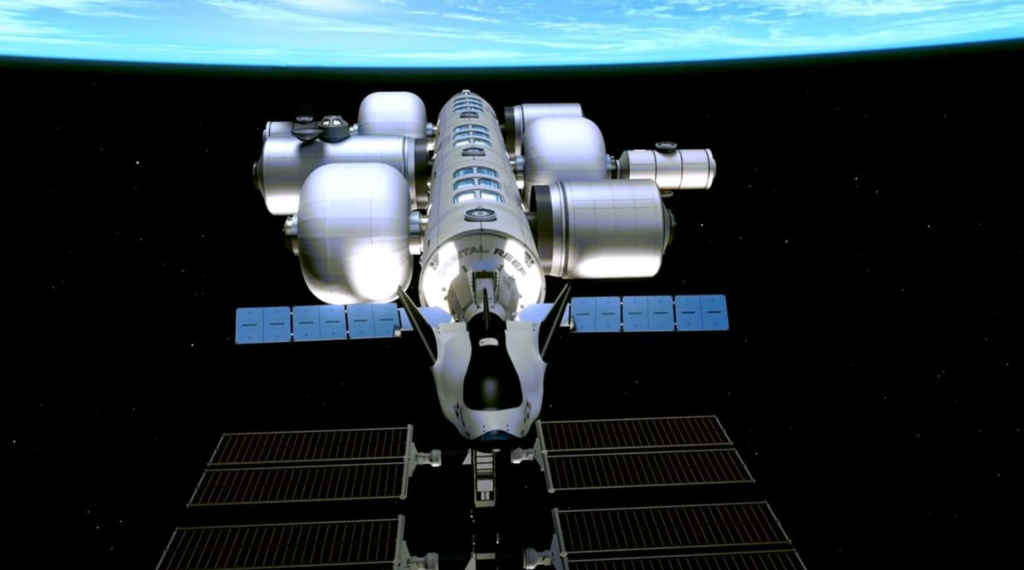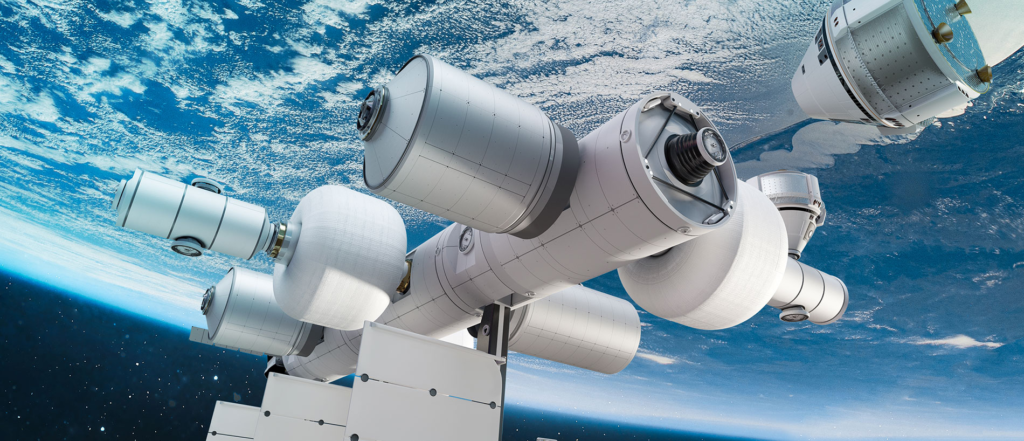
What Is The Progress On Orbital Reef?
Over the past year, we have received a bunch of new information on future ambitious projects. This includes a lot of next generation launch vehicles but also some new destinations as well. Specifically low Earth orbit destinations meant to change how we access and operate within space. Orbital Reef is a great example with multiple big companies planning to contribute.
Since Orbital Reef’s announcement not long ago towards the end of 2021, some of the companies involved have provided updates on the space station. This brings up the question of what progress has been made and how are some of the launch vehicles expected to carry segments and people progressing. In order for this project to be a success, many different moving parts need to work perfectly.
Orbital Reef is intended to be a commercially developed, owned, and operated space station to be built in low Earth orbit. Companies like Blue Origin expect it to facilitate the growth of a vibrant ecosystem and business model for the future. Here I will go more in-depth into some of the recent updates regarding this station, what progress has been made, and what to expect in the future.
Recent Updates

Before looking at the progress of this station, I need to go over some of the background information. Orbital Reef is backed by companies and teammates including Boeing, Redwire Space, Genesis Engineering Solutions, and Arizona State University. Designed to open multiple new markets in space, Orbital Reef will provide anyone with the opportunity to establish their own address on orbit. This unique destination will offer research, industrial, international, and commercial customers the cost competitive end-to-end services they need including space transportation and logistics, space habitation, equipment accommodation, and operations including onboard crew. In terms of a date, they are confident the station will start operating in the second half of this decade.
Orbital Reef will be operated as a “mixed use business park” in space. Shared infrastructure efficiently supports the proprietary needs of diverse tenants and visitors. It features a human-centered space architecture with world-class services and amenities that is inspiring, practical, and safe. As the premier commercial destination in low Earth orbit, Orbital Reef will provide the essential infrastructure needed to scale economic activity and open new markets in space. Reusable space transportation and smart design, accompanied by advanced automation and logistics, will minimize cost and complexity for both traditional space operators and new arrivals, allowing the widest range of users to pursue their goals. The open system architecture allows any customer or nation to link up and scale to support demand. Module berths, vehicle ports, utilities, and amenities all increase as the market grows.
It’s important to point out that this project heavily relies on multiple companies’ future projects. For example, Blue Origin is expected to provide, utility systems, large-diameter core modules, and reusable heavy-lift New Glenn launch system. Next, is Sierra Space providing a large Integrated Flexible Environment (LIFE) module, node module, and runway-landing Dream Chaser spaceplane for crew and cargo transportation, capable of landing on runways worldwide. Then Boeing, with science modules, station operations, maintenance engineering, and Starliner crew spacecraft. These are just three of the companies involved all of which are expected to provide new technology and launch vehicles.
The three main items out of that long list of all the companies that we should take a closer look at include New Glenn, Dream Chaser, and Starliner. In order for Orbital Reef to be successful and created in a timely manner, each of these launch vehicles are expected to be ready not long from now. Starting with New Glenn which has the very necessary job of bringing the modules themselves into LEO. One of the most recent substantial updates on New Glenn came in the form of a few tweets from Blue Origin late last year. In early November the company tweeted saying, “As #NewGlenn makes progress towards first flight, testing with the GS1 simulator will enable the team to practice ground ops for New Glenn’s massive first stage including the transport from the rocket manufacturing complex to LC-36 for integration.” This included an image of the test article being transported. They went on to say, “While not destined for flight, this hardware is giving our team invaluable data to inform future launch vehicle operations.” The New Glenn launch vehicle has experienced some delays over the past few years. Not long ago the company pushed dates back to late this year, however it seems it may be longer before we watch this rocket go through some significant testing.
Next is Dream Chaser which has made some significant progress recently. Not long ago we watched the assembly of Dream Chaser Tenacity and more updates regarding this launch vehicle. Designed for high reusability, this vehicle is trying to reduce overall cost, providing quick turnarounds between missions. The ability to liftoff on top of multiple launch vehicles and land at a wide variety of runways makes Dream Chaser a flexible option for reliable transportation. Dream Chaser was originally designed as a crewed spaceplane, in part under NASA’s Commercial Crew Program, capable of carrying up to seven astronauts to and from the space station and other low Earth orbit (LEO) destinations. Dream Chaser is 30 feet, or 9 meters long—roughly ¼ the total length of the space shuttle orbiters—and can carry up to seven crew members. This spaceplane is intended to bring both crew and cargo to the station.
Finally, we have Starliner. While this spacecraft had a bit of a rocky start with the original orbital flight test to the International Space Station, it recently had a successful flight to the ISS during its second OFT. This spacecraft is the most tested out of the three launch vehicles and projects expected to be used for Orbital Reef in the near future. A big part of keeping track of Orbital Reef involves taking a closer look at some of the ambitious projects it relies on.
Orbital Reef

Now that we know more about some of the companies Orbital Reef relies on, we can take a closer look at the project itself and some of the roles they play. One important aspect is the inflatable LIFE habitat, the orbital platform will offer tenants and visitors world-class amenities while providing convenient access to the unique opportunities inherent to the zero-gravity orbital environment. Despite prioritizing comfort, Orbital Reef is designed to be optimal, not opulent. Innovators have long dreamed of the new markets that could be opened with reliable commercial access to the cosmos. From mining to medicine to even microgravity research, the human endeavors capable of flourishing amongst the stars are myriad, and for the first time, Sierra Space’s Orbital Reef will attempt to empower intrepid individuals to harness such potential even if the civilians involved aren’t worth billions or haven’t undergone punishing training to become world class astronauts.
Beyond the central LIFE habitat, Orbital Reef will also feature smaller node modules and a port for Sierra Space’s Dream Chaser. Orbital Reef’s prototype features a science lab, a medical bay, a hydroponics garden, a bathroom, a galley, and crew quarters. This basic model can easily be expanded upon, however, offering unique opportunities for scaling up once tomorrow’s space opportunists start taking advantage of this first-of-its-kind, privately owned, mixed-use orbital business park. Allowing individuals involved in research, industry, or even international diplomacy to collaborate in Earth’s orbit for the first time, Orbital Reef promises to usher in a new era of prosperity and innovation that comes into focus once we leave our planet’s atmosphere—and limited modes of thinking—behind.
Designed to ideally accommodate human inhabitants while also offering unique access to space-based robotics and other research technologies, Orbital Reef’s first priority is nonetheless to keep its occupants safe. It’s true that the space domain presents unique dangers to explorers and entrepreneurs alike, but the same could be said for any frontier humanity has ever come up against during its long, storied history. Did we turn back at the shores of the Atlantic or the slopes of the Rockies? If we had, none of us would be here today. What new vistas might elude us should we not embrace an exciting frontier we can scarcely imagine? All of which relies on the success of a large list of individual projects, some of which I mentioned prior.
Conclusion
Not long ago we received the big announcement about Orbital Reef and the plans to change how we access and live in space. It included a list of big companies and contributors all with a different purpose. Since then we have watched some companies progress more than others. We will have to wait and see how it progresses and the impact it has on the space industry.
